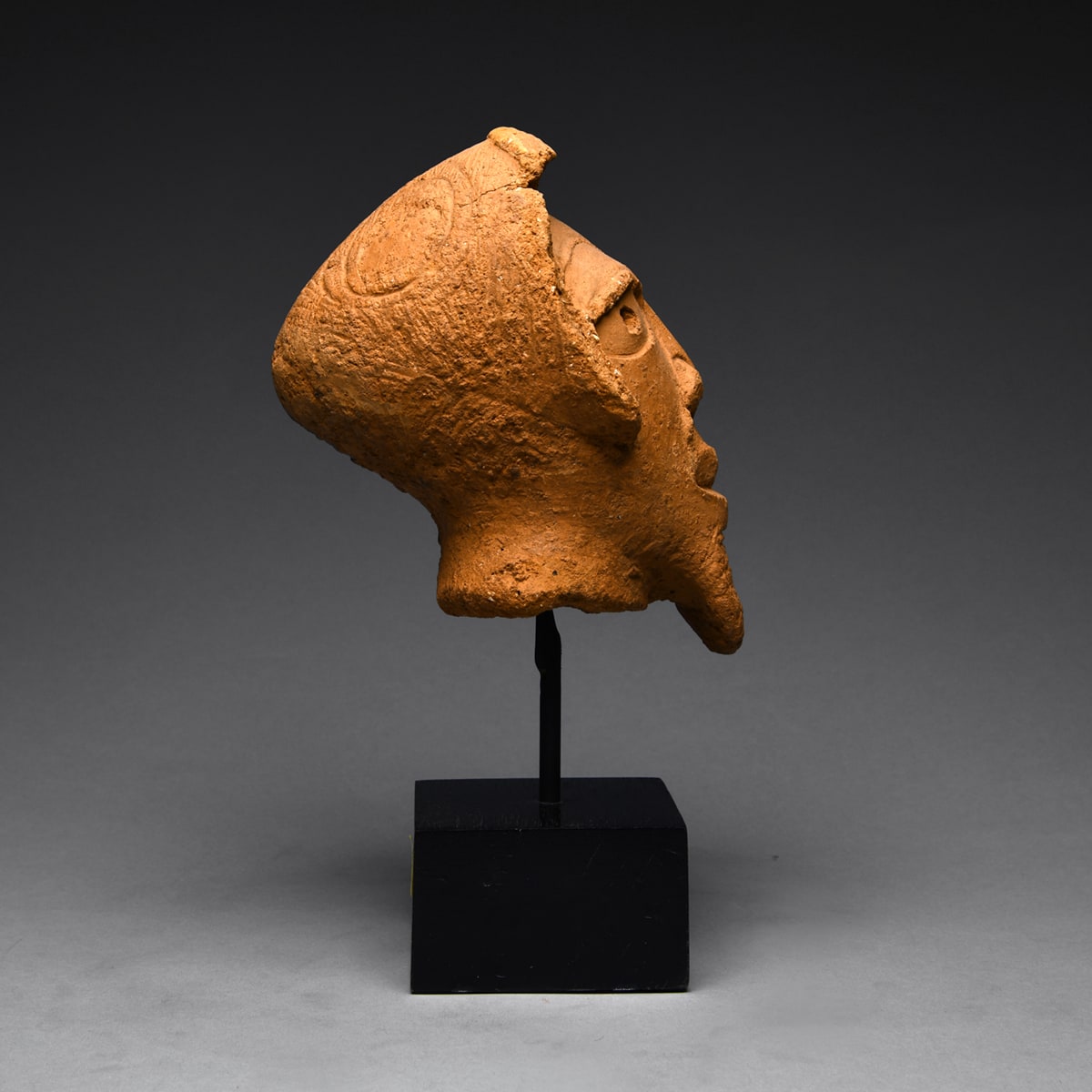Nok Terracotta Head, 300 BCE - 300 CE
Terracotta
PF.0387D
Further images
The terracotta statuary of the Nok Culture is a classic art style whose sudden appearance has radically challenged the traditional art history of African Sculpture. THE ICONOGRAPHY OF NOK ART....
The terracotta statuary of the Nok Culture is a classic art style whose sudden appearance has radically challenged the traditional art history of African Sculpture. THE ICONOGRAPHY OF NOK ART. Four main characteristics distinguish the NOK STYLE. ?
1. The treatment of the eyes, which form either a segment of a circle or sometimes a triangular form, with the eyebrow above balancing the sweep of the lower lip, sometimes making a circle. ?
2. The piercing of the pupils, the nostrils, the lips and the ears. ?
3. The careful representation of elaborate hairstyles, with complex constructions buns, tresses, locks and the profusion of beads around the neck, torso and waist. ?
4. The realism in the modeling of the curled lips, the straight nose with flaring nostrils and the large overhanging forehead. The earliest known sculpture of large size in the Sudan is that produced in pottery by the Nok culture, which flourished extensively in northern Nigeria from the 5th century BC into the early centuries AD. These people were the first known manufacturers of iron in western Africa, furnaces at Taruga having been dated between the 5th and early 3rd centuries BC; they continued, however, to use stone tools. Of well-fired clay, their sculptures represent animals naturalistically; human figures, however, are depicted with heads that are usually tubular, but sometimes conical or spherical, and with simple tubular trunks and limbs. The art of Nok indicates the antiquity of many basic canons of West African sculpture, but the precise relationship between ancient and modern forms is obscure.?
?
Nok figures where made for religious purpose as proved by subject and attitude.?
?
Nok terracotta figures are cult objects representing deities, spirit figures, mythical beings or deified ancestors.?
?
Some of the earliest examples of sophisticated sculpture in sub-Saharan Africa come from the Nok culture. We do not know what the people called themselves, so the culture was named after the town of Nok where the first object was found. The fired clay or terracotta sculptures range in size from small pendant to life-size figures. Nok is an iron age culture that has been dated between 900 B.C. and 200 A.D. Archaelogical artifacts have been found in Nigeria, primarily to the north of the Niger-Benue River confluence and below the Jos escarpment. According to some accounts, based on artistic similarities between early Yoruba art forms and Nok forms, there may be connections between Nok culture and contemporary Yoruba peoples.
1. The treatment of the eyes, which form either a segment of a circle or sometimes a triangular form, with the eyebrow above balancing the sweep of the lower lip, sometimes making a circle. ?
2. The piercing of the pupils, the nostrils, the lips and the ears. ?
3. The careful representation of elaborate hairstyles, with complex constructions buns, tresses, locks and the profusion of beads around the neck, torso and waist. ?
4. The realism in the modeling of the curled lips, the straight nose with flaring nostrils and the large overhanging forehead. The earliest known sculpture of large size in the Sudan is that produced in pottery by the Nok culture, which flourished extensively in northern Nigeria from the 5th century BC into the early centuries AD. These people were the first known manufacturers of iron in western Africa, furnaces at Taruga having been dated between the 5th and early 3rd centuries BC; they continued, however, to use stone tools. Of well-fired clay, their sculptures represent animals naturalistically; human figures, however, are depicted with heads that are usually tubular, but sometimes conical or spherical, and with simple tubular trunks and limbs. The art of Nok indicates the antiquity of many basic canons of West African sculpture, but the precise relationship between ancient and modern forms is obscure.?
?
Nok figures where made for religious purpose as proved by subject and attitude.?
?
Nok terracotta figures are cult objects representing deities, spirit figures, mythical beings or deified ancestors.?
?
Some of the earliest examples of sophisticated sculpture in sub-Saharan Africa come from the Nok culture. We do not know what the people called themselves, so the culture was named after the town of Nok where the first object was found. The fired clay or terracotta sculptures range in size from small pendant to life-size figures. Nok is an iron age culture that has been dated between 900 B.C. and 200 A.D. Archaelogical artifacts have been found in Nigeria, primarily to the north of the Niger-Benue River confluence and below the Jos escarpment. According to some accounts, based on artistic similarities between early Yoruba art forms and Nok forms, there may be connections between Nok culture and contemporary Yoruba peoples.







